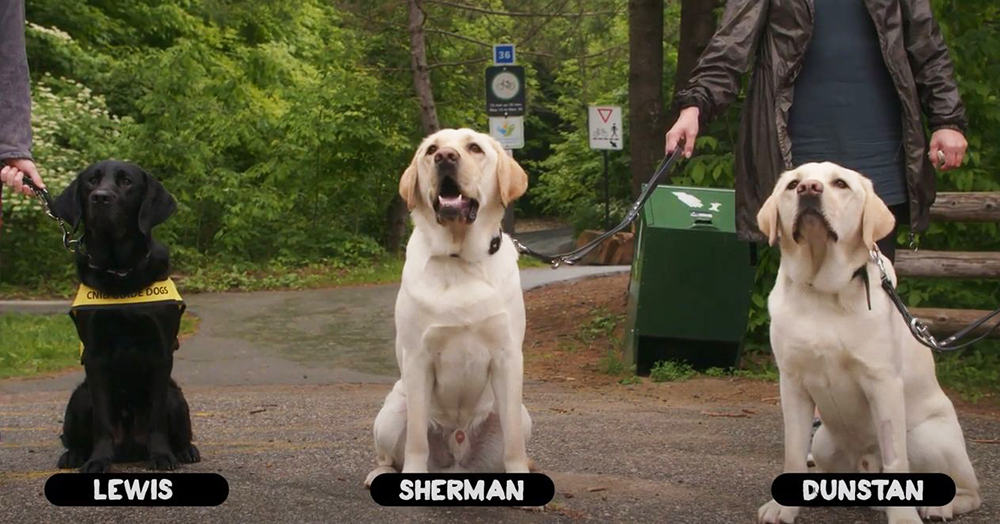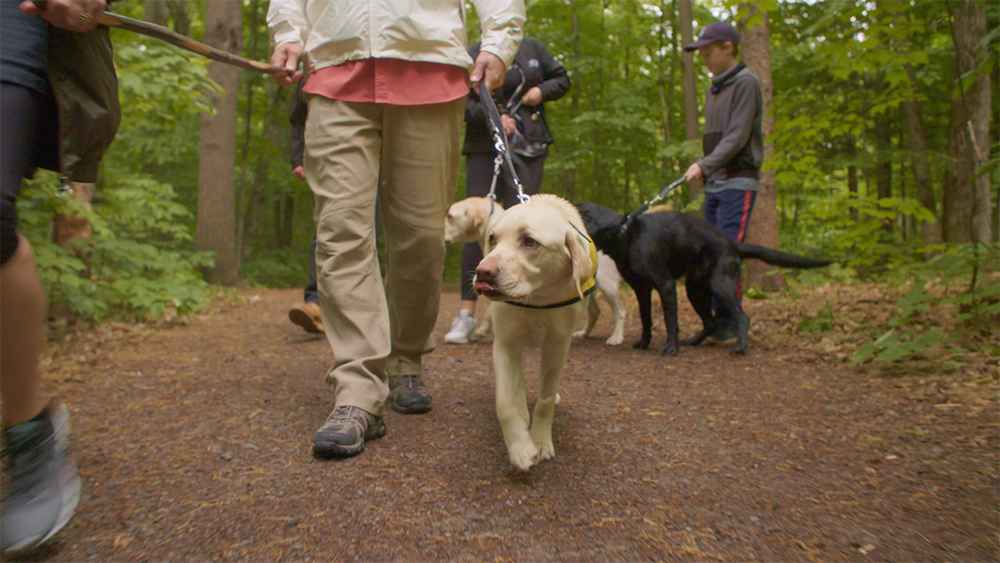Episode 5: Hiking and Canoeing – Part 1: Hiking
Hiking can cover a lot of territory, if not literally, then figuratively. In a nutshell, it really comes down to taking a long walk in nature. That’s what I’ve always liked to do since my earliest memories, when my father would rally the family and we would set off for a hike through our 200-acre property equipped only with handmade wooden hiking poles. These hikes wouldn’t last more than a couple of hours, but they were always greeted by my brothers and I with a strong sense of anticipation. So how has my approach to hiking changed over time as my eyesight has gradually disappeared? And where do guide dogs come into play? Years of hiking experience has taught that hiking is an essential outdoor experience for CNIB’s guide dog trainees, as this episode will demonstrate.
Hiking with a guide dog isn’t something that you can easily learn from fellow hikers. Most blind people have little experience of how to get the best use from a guide dog when going off the grid. Hiking is not taught to guide dogs during their training. Some might even argue that hiking could cause guide dog confusion about what’s doable and what’s not in relation to terrain and obstacles.
I’ve been going off-line with my guide dogs since 1986. Most dogs love going into the bush or travelling along trails that follow rivers or skirt rocky outcrops. Hiking means allowing a guide dog to relax the rules a bit concerning what they need to watch out for, and at the same time, to learn to identify any obstacles that a blind hiker needs to know about.
Andrew Hanlon, director of CNIB’s Guide Dog Program, was keen to join my family and I on a relatively non-technical hike in the Gatineau hills. He brought along three guide dog trainees: Dunstan, Sherman, and Lewis. It was a drizzly day, and the bugs were out, but that was all O.K. as we were heading into the forest and were properly equipped.
As always, my wife Anne would take the lead, and would be the one wearing the bear bell. These bells not only alert black bears of our approach so we don’t startle one and cause it to exhibit aggression, but they also give an audible beacon to follow. Five of us, Anne, our two kids, Lilly and Theo, Andrew and I would take turns healing the three dogs.
The goal was to determine which of the dogs would exert a desire to assume a leadership role, which dog would be most comfortable in the middle of the pack, and which dog would be happy to be taking up the rear. As with all our outdoor challenges, no guide dog harness would be used.
When I hike with my guide dog, I do what most trainers caution against. I drop the harness and hold the leash with one hand, and in my other hand I have a long wooden hiking pole. The reason trainers don’t like it when blind people allow their guide dogs to pull them along using the leash only, is that it’s a relatively inaccurate technique in comparison to using the harness. The rule is that if you are holding the leash and not the harness, and you bump into something, it’s not the dog’s fault.
Holding your guide dog’s harness can be impractical if the width of the hiking trail doesn’t accommodate walking side-by-side with your dog in harness. Since most trails are not that wide, this means the dog must either follow, which is sort of pointless, or get out ahead and assume leadership. Harness handles are only so long, so when the dog is in front you have no choice but to drop the handle and hold the leash only.
The purpose of bringing a wooden hiking staff is to assess significant obstacles when the dog slows or comes to a stop, to help maintain balance when traversing uneven or soft ground, for pushing aside branches and brush that might cause injury to your face, and to assess the distances involved when stepping over large obstacles such as when ascending or descending hills. It’s always nice to know just how far down that next step is going to be before you actually commit.
Another purpose for the staff is for conveying information about a trail that is much more technical. Instead of feeling the terrain with the stick, which can slow down the progress of a hike considerably, it’s often easier to have someone walk in front of you holding the tip of your hiking staff. You can follow their direction and be alerted to sudden changes in elevation. You can also be guided over and around obstacles. There’s a lot more information being conveyed together with a few key words than what a dog can provide through a leash alone.
So, to review, you can hike holding on to your dog’s harness when the trail is sufficiently wide. You can traverse relatively non-technical narrow trails by simply holding on to your dog’s leash and asking that they walk ahead of you, all the time keeping your hiking staff handy to assess the nature of the obstacle when your dog slows or stops. You can ask the dog to follow you and have a fellow hiker hold the tip of your hiking staff when the trail conditions become much more technical.
I often use all three of these techniques when hiking. This especially holds true when hiking up the back of mountains when switchbacks are involved, when loose scree is encountered, and when snow cornices are a feature of the mountain peak. A snow cornice? A what? you may ask. A snow cornice results when prevailing wind blows snow off the top of the mountain causing it to build up on the vertical face of the rock face, creating an artificial snowy trail next to the rock. I say artificial, as these cornices are often no more than a meter wide, and more importantly, a meter thick. It’s super important that you don’t let your dog take you on to a snow cornice, or to allow your dog to walk on the snow, which they will want to do to cool down their blood. Remember, dogs don’t sweat, they radiate excess heat through their foot pads and by panting. A snow cornice will not support your weight, or the weight of your guide dog. Since they normally form at the peeks of mountains, there can be many thousands of feet of open air below a cornice. Look out!
So how did we do?
All three dogs demonstrated comfort and contentment in the forest. They were eager to learn what waited for them at the end of the trail, which is good, since a dog that does not show curiosity also quite often isn’t the brightest. Lead position was competed over by Sherman and Lewis. I expected as much from Sherman, being a large male. But I was surprised by Lewis’s desire to take the lead because I had the impression that he would be more interested in goofing around, than in taking a leadership role. Interesting…
While our hike may not have challenged the dogs technically, given that these are still young guide dog trainees, it would have been irresponsible to push the dogs beyond their comfort and skill level. Technical hikes should only be attempted once you have established a solid working relationship with your guide dog, and the bond between you is strong. Things happen out there in the wild, and you don’t want to sour a brand-new guide dog by pushing it beyond what the two of you have accomplished to date. Build up slowly, learn what works and, especially, what doesn’t, and adjust accordingly the next time you head out.
A few more tips to close: Always keep in mind the safety of your dog’s paws, especially when traversing loose scree or rock. Let the dog pick its path and stay back so you don’t cause rocks to shift and cause injury to their paws. Ware a wide brim hat with a string to hold it on your head. And be sure to wear safety glasses or sunglasses to make sure you don’t get a stick in the eye. Bring water, and make sure your dog knows how to drink from a water bottle – this is something to practice at home outside.





